
Tourism Places In udaipurFateh Sagar Lake 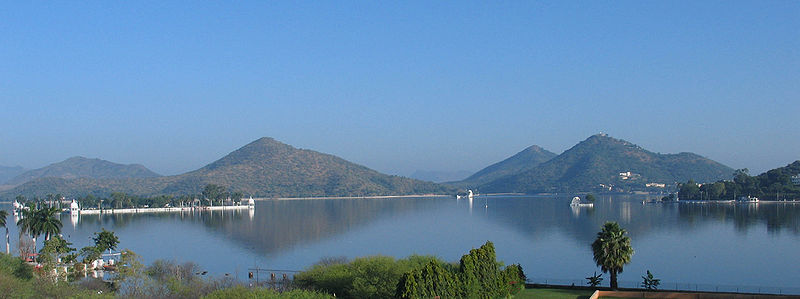 Fateh Sagar Lake is situated in udaipur city in the Indian state of Rajasthan. Said to be the pride of the City of Lakes of udaipur, it is an artificial lake constructed by Maharana in north of Lake Pichola in 1678 and to the north-west of udaipur.
It is one of the four lakes of the udaipur city are the Lake Pichola (within the udaipur town), Udai Sagar Lake (13 km to the east of udaipur) and Dhebar Lake or Jaisamand Lake (52 km south east of udaipur).Within the confines of the Fateh Sagar Lake, there are three small islands. the largest of these is the island called the Nehru Park (4 sq.km area), which is a popular garden with a restaurant and a zoo, the second island (0.06 sq. km area) houses a public park with an impressive water-jet fountain and the third island (1.2 sq.km area) is the address for the udaipur Solar Observatory (USO). The Nehru park is accessed by inboard motor boats from the bottom of Moti Magri. Blue waters of the lake and the backdrop of green has given the soubriquet of 'the second Kashmir' to udaipur town udaipur Lake Conservation Society's reports indicate that the lake supports and sustains ground water recharge, drinking water, agricultural use, industrial use, ecological water availability and provides employment to 60% population of udaipur.
In the year 1687 A.D, Maharana Jai Singh first constructed the lake but two hundred years later the earthen bund which formed the lake was washed away during floods, and thereafter Maharana Fateh Singh, the ruler of former Mewar State, reconstructed it in the year 1888 A.D. The Duke of Connaught, third son of Queen Victoria laid the foundation stone for the new construction. The lake is now named after the king, as "Fateh Sagar Lake".
Fateh Sagar Lake is situated in udaipur city in the Indian state of Rajasthan. Said to be the pride of the City of Lakes of udaipur, it is an artificial lake constructed by Maharana in north of Lake Pichola in 1678 and to the north-west of udaipur.
It is one of the four lakes of the udaipur city are the Lake Pichola (within the udaipur town), Udai Sagar Lake (13 km to the east of udaipur) and Dhebar Lake or Jaisamand Lake (52 km south east of udaipur).Within the confines of the Fateh Sagar Lake, there are three small islands. the largest of these is the island called the Nehru Park (4 sq.km area), which is a popular garden with a restaurant and a zoo, the second island (0.06 sq. km area) houses a public park with an impressive water-jet fountain and the third island (1.2 sq.km area) is the address for the udaipur Solar Observatory (USO). The Nehru park is accessed by inboard motor boats from the bottom of Moti Magri. Blue waters of the lake and the backdrop of green has given the soubriquet of 'the second Kashmir' to udaipur town udaipur Lake Conservation Society's reports indicate that the lake supports and sustains ground water recharge, drinking water, agricultural use, industrial use, ecological water availability and provides employment to 60% population of udaipur.
In the year 1687 A.D, Maharana Jai Singh first constructed the lake but two hundred years later the earthen bund which formed the lake was washed away during floods, and thereafter Maharana Fateh Singh, the ruler of former Mewar State, reconstructed it in the year 1888 A.D. The Duke of Connaught, third son of Queen Victoria laid the foundation stone for the new construction. The lake is now named after the king, as "Fateh Sagar Lake".City Palace 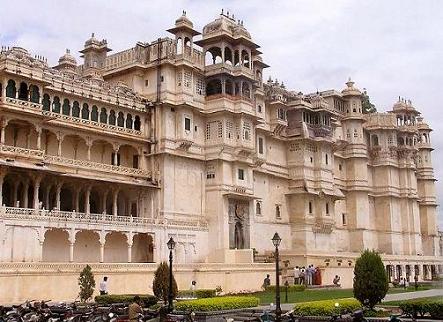 City Palace udaipur is a palace complex in udaipur,of the Indian state Rajasthan. It was built by the Maharana Udai Singh as the capital of the Sisodia Rajput clan in 1559, after he moved from Chittor. It is located on the east bank of the Lake Pichola and has several palaces built within its complex. udaipur was the historic capital of the former kingdom of Mewar in the Rajputana Agency and its last capital
The City Palace in udaipur was built in a flamboyant style and is considered the largest of its type in Rajasthan, a fusion of the Rajasthani and Mughal architectural styles, and was built on a hill top that gives a panoramic view of the city and its surrounding, including several historic monuments such as the Lake Palace in Lake Pichola, the Jag Mandir on another island in the lake, the Jagdish Temple close to the palace, the Monsoon Palace on top of an overlooking hillock nearby and the Neemach Mata temple. These structures are linked to the filming of the Hollywood movie Octopussy, which features the Lake Palace and the Monsoon Palace. The subsequent publicity has resulted in the epithet of udaipur as "Venice of the East". In 2009, udaipur was rated the top city in the World's Best Awards by Travel plus Leisure.
City Palace udaipur is a palace complex in udaipur,of the Indian state Rajasthan. It was built by the Maharana Udai Singh as the capital of the Sisodia Rajput clan in 1559, after he moved from Chittor. It is located on the east bank of the Lake Pichola and has several palaces built within its complex. udaipur was the historic capital of the former kingdom of Mewar in the Rajputana Agency and its last capital
The City Palace in udaipur was built in a flamboyant style and is considered the largest of its type in Rajasthan, a fusion of the Rajasthani and Mughal architectural styles, and was built on a hill top that gives a panoramic view of the city and its surrounding, including several historic monuments such as the Lake Palace in Lake Pichola, the Jag Mandir on another island in the lake, the Jagdish Temple close to the palace, the Monsoon Palace on top of an overlooking hillock nearby and the Neemach Mata temple. These structures are linked to the filming of the Hollywood movie Octopussy, which features the Lake Palace and the Monsoon Palace. The subsequent publicity has resulted in the epithet of udaipur as "Venice of the East". In 2009, udaipur was rated the top city in the World's Best Awards by Travel plus Leisure.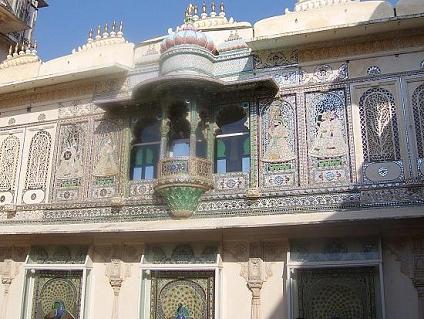 The city Palace was built concurrently with establishment of the udaipur city by Maharana Udai Singh, in 1559 and his successor Maharanas over a period of the next 300 years. It is considered the largest royal complex in Rajasthan and is replete with history. Founding of the city and building of the palace complex can not be looked in isolation as the Maharanas lived and administered their kingdom from this palace
Prior to moving their capital from Chittor to udaipur, the Mewar kingdom had flourished initially in Nagda (30 kilometres (19 mi) to the north of udaipur), established in 568 AD by Guhil, the first Mewar Maharana. In the 8th century, the capital was moved to Chittor, a hill top fort from where the Sisodias ruled for 80 years. Maharana Udai Singh inherited the Mewar kingdom at Chitttor in 1537 but by that time there were signs of loosing control of the fort in wars with the Mughals. Udai Singh II, therefore, chose the site near Lake Pichola for his new kingdom because the location was well protected on all sides by forests, lakes and the Aravalli hills. He had chosen this site for his new capital, much before the sacking of Chittor by Emperor Akbar, on the advise of a hermit he had met during one of his hunting expeditions
At his capital Chittor, Maharana Udai Singh soon faced defeat at the hands of Mughal Emperor Akbar. He soon moved to udaipur to the chosen location to establish his new capital. The earliest royal structure he built here was the Royal courtyard or 'Rai Angan', which was the begining of the building of the City Palace complex, at the place where the hermit had advised Maharana to build his Capital
After Udai Singh's death in 1572, his son Maharana Pratap took the reins of power at udaipur. He was successful in defeating Akbar at the battle of Haldighati in 1576 and thereafter udaipur was peaceful for quite some years. With this, prosperity of udaipur ensued, palaces were built on the shore and in the midst of the Pichola lake. Concurrently art, particularly miniature painting, also flourished.
But in 1736, the marauding Marathas attacked udaipur and by the end of the century the Mewar state was in dire straits and in ruins. However, the British came to Mewar's rescue in the 19th century and soon the State of Mewar got re-established and prospered under British protection, under a treaty signed with the British. However, the British were not allowed to replace them. Once India got independence in 1947, the Mewar Kingdom, along with other princely states of Rajasthan, merged with the Democratic India, in 1949. The Mewar Kings subsequently also lost their special royal privileges and titles. However, the successor Maharanas have enjoyed the trust of their people and also retained their ownership of the palaces in udaipur. They are now running the palaces by creating a trust, called the Mewar Trust, with the income generated from tourism and the heritage hotels that they have established in some of their palaces. With the fund so generated they are running charitable hospitals, educational institutions and promoting the cause of environmental preservation.
The city Palace was built concurrently with establishment of the udaipur city by Maharana Udai Singh, in 1559 and his successor Maharanas over a period of the next 300 years. It is considered the largest royal complex in Rajasthan and is replete with history. Founding of the city and building of the palace complex can not be looked in isolation as the Maharanas lived and administered their kingdom from this palace
Prior to moving their capital from Chittor to udaipur, the Mewar kingdom had flourished initially in Nagda (30 kilometres (19 mi) to the north of udaipur), established in 568 AD by Guhil, the first Mewar Maharana. In the 8th century, the capital was moved to Chittor, a hill top fort from where the Sisodias ruled for 80 years. Maharana Udai Singh inherited the Mewar kingdom at Chitttor in 1537 but by that time there were signs of loosing control of the fort in wars with the Mughals. Udai Singh II, therefore, chose the site near Lake Pichola for his new kingdom because the location was well protected on all sides by forests, lakes and the Aravalli hills. He had chosen this site for his new capital, much before the sacking of Chittor by Emperor Akbar, on the advise of a hermit he had met during one of his hunting expeditions
At his capital Chittor, Maharana Udai Singh soon faced defeat at the hands of Mughal Emperor Akbar. He soon moved to udaipur to the chosen location to establish his new capital. The earliest royal structure he built here was the Royal courtyard or 'Rai Angan', which was the begining of the building of the City Palace complex, at the place where the hermit had advised Maharana to build his Capital
After Udai Singh's death in 1572, his son Maharana Pratap took the reins of power at udaipur. He was successful in defeating Akbar at the battle of Haldighati in 1576 and thereafter udaipur was peaceful for quite some years. With this, prosperity of udaipur ensued, palaces were built on the shore and in the midst of the Pichola lake. Concurrently art, particularly miniature painting, also flourished.
But in 1736, the marauding Marathas attacked udaipur and by the end of the century the Mewar state was in dire straits and in ruins. However, the British came to Mewar's rescue in the 19th century and soon the State of Mewar got re-established and prospered under British protection, under a treaty signed with the British. However, the British were not allowed to replace them. Once India got independence in 1947, the Mewar Kingdom, along with other princely states of Rajasthan, merged with the Democratic India, in 1949. The Mewar Kings subsequently also lost their special royal privileges and titles. However, the successor Maharanas have enjoyed the trust of their people and also retained their ownership of the palaces in udaipur. They are now running the palaces by creating a trust, called the Mewar Trust, with the income generated from tourism and the heritage hotels that they have established in some of their palaces. With the fund so generated they are running charitable hospitals, educational institutions and promoting the cause of environmental preservation. Jag Mandir 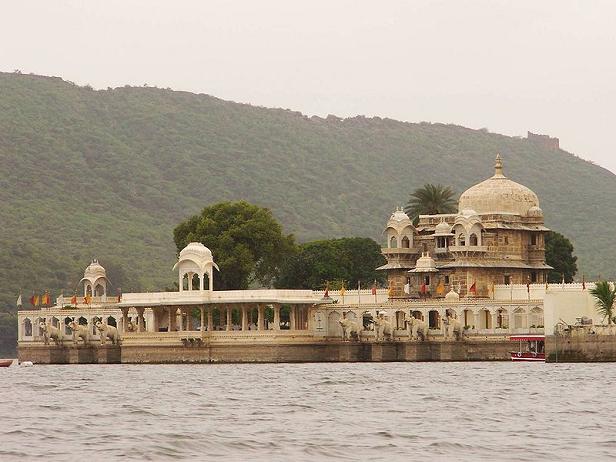 Jag Mandir is a palace built on an island in the Lake Pichola. It is, therefore, also called the "Lake Garden Palace". The palace is located in udaipur city in the Indian state of Rajasthan. Its construction is credited to three Maharanas of the Sisodia Rajputs of Mewar kingdom. The construction of the palace was started in 1551 by Maharana Amar Singh, continued by Maharana Karan Singh (1620-1628) and finally completed by Maharana Jagat Singh I (1628-1652). It is named as "Jagat Mandir" in honour of the last named Maharana Jagat Singh. The royal family used the palace as a summer resort and pleasure palace for holding parties
The palace served as a refuge to asylum seekers on two separate occasions
Jag Mandir's history begins with the Maharana Karan Singh's benevolence shown to Emperor Shahjahan (1605-1627). Shahjahan, before he was crowned as Mughal Emperor, was known during his young days as Prince Khurram. As Khurram, he rebelled against his father Emperor Jahangir in 1623, because he wanted to be the heir to the Mughal throne. Faced with danger of getting thwarted in his campaign, he sought refuge in Mewar Kingdom at udaipur where he was given safe haven by the then Maharana Karan Singh (it is said that this courtesy was extended because Khurram's mother was a Rajput Hindu lady). He was initially kept in the City Palace along with his wife Mumtaz Mahal and his two sons, Prince Dara and Prince Aurangzeb. Later they were shifted to the Gul Mahal, as a safe refuge, in the midst of the lake (this place since then has also been called Khurram's Palace). Gul Mahal is a domed pavilion that was specially built for Khurram by Maharana Karan Singh. It was later enlarged by his son Jagat Singh into a huge palace and named as the Jag Mandir palace. Khurram remained under Mewar's protection during 1623-1624.
Jag Mandir is a palace built on an island in the Lake Pichola. It is, therefore, also called the "Lake Garden Palace". The palace is located in udaipur city in the Indian state of Rajasthan. Its construction is credited to three Maharanas of the Sisodia Rajputs of Mewar kingdom. The construction of the palace was started in 1551 by Maharana Amar Singh, continued by Maharana Karan Singh (1620-1628) and finally completed by Maharana Jagat Singh I (1628-1652). It is named as "Jagat Mandir" in honour of the last named Maharana Jagat Singh. The royal family used the palace as a summer resort and pleasure palace for holding parties
The palace served as a refuge to asylum seekers on two separate occasions
Jag Mandir's history begins with the Maharana Karan Singh's benevolence shown to Emperor Shahjahan (1605-1627). Shahjahan, before he was crowned as Mughal Emperor, was known during his young days as Prince Khurram. As Khurram, he rebelled against his father Emperor Jahangir in 1623, because he wanted to be the heir to the Mughal throne. Faced with danger of getting thwarted in his campaign, he sought refuge in Mewar Kingdom at udaipur where he was given safe haven by the then Maharana Karan Singh (it is said that this courtesy was extended because Khurram's mother was a Rajput Hindu lady). He was initially kept in the City Palace along with his wife Mumtaz Mahal and his two sons, Prince Dara and Prince Aurangzeb. Later they were shifted to the Gul Mahal, as a safe refuge, in the midst of the lake (this place since then has also been called Khurram's Palace). Gul Mahal is a domed pavilion that was specially built for Khurram by Maharana Karan Singh. It was later enlarged by his son Jagat Singh into a huge palace and named as the Jag Mandir palace. Khurram remained under Mewar's protection during 1623-1624.
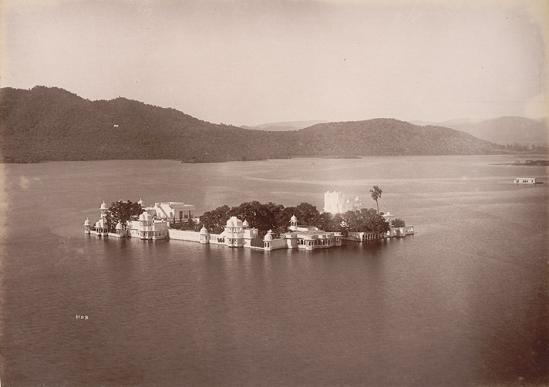 The irony of this act of hospitality shown by Karan Singh to Khurram is that his father Maharana Amar Singh had been defeated in the war in 1614 by Khurram. Later, prince Karan Singh had acted as an envoy to the Mughal court, and cordial amity developed between the two rival kingdoms of Mewar and the Mughals. This relationship helped Khurram who was subsequently, in the year 1623, given refuge in Jag Mandir by Maharana Karana Singh. Following the death of Jahangir in 1627, Khurram ascended the throne of the Mughal Empire. It is said that Khurram was bestowed the title of Shah Jahan at the Badal Mahal in udaipur before he left udaipur for his crowning as the Mughal emperor. As an act of reward, Khurram not only restored six districts to the Mewar kingdom, which had been earlier annexed by the Mughals, but also presented a unique ruby jewel to Jagat Singh, son of Rana Karan Singh. After Karan Singh's death in 1628, Jagat Singh (1628-1652) became the Maharana. He was responsible for many additions to the Gul Mahal and called it the Jag Mandir, after himself. For building this remarkable structure, Maharana Jagat Singh was hailed as one of the best architects of the Mewar dynasty. Khurram, after becoming Emperor Shahjahan, particularly favoured the Maharana of udaipur, which enabled the Mewar kingdom to regain its past glory.
Following the unusual friendship between the Mughals and the Mewar kingdom, peace prevailed, except for occasional threats posed by Aurangzeb. However the real threat, which almost decimated Mewar kingdom for many years, came from the marauding Marathas. Hope of survival revived when in 1817, the British came to their rescue with the "Treaty of Paramountcy" promising restoration of all the hereditary territories and protecting the state from any future invasions. Thereafter, peace and prosperity ensued in Mewar Kingdom. The pride and glory of Sisodia Rajputs were fully restored
During the revolt in 1857, Maharana Swroop Singh (1842-1861) saved a number of European families, mostly women and children from Neemuch, which were given refuge in the Jag Mandir palace. The revolt was popularly known as the Sepoy Mutiny, and was also called the Indian Mutiny, or the first War of Independence) against the British Raj
After the Independence of India from the British rule, on 15 August 1947, at the initiative of Maharana Bhupal Singh, the Mewar kingdom merged with the Indian union in 1949 along with other princely states of Rajasthan.
The irony of this act of hospitality shown by Karan Singh to Khurram is that his father Maharana Amar Singh had been defeated in the war in 1614 by Khurram. Later, prince Karan Singh had acted as an envoy to the Mughal court, and cordial amity developed between the two rival kingdoms of Mewar and the Mughals. This relationship helped Khurram who was subsequently, in the year 1623, given refuge in Jag Mandir by Maharana Karana Singh. Following the death of Jahangir in 1627, Khurram ascended the throne of the Mughal Empire. It is said that Khurram was bestowed the title of Shah Jahan at the Badal Mahal in udaipur before he left udaipur for his crowning as the Mughal emperor. As an act of reward, Khurram not only restored six districts to the Mewar kingdom, which had been earlier annexed by the Mughals, but also presented a unique ruby jewel to Jagat Singh, son of Rana Karan Singh. After Karan Singh's death in 1628, Jagat Singh (1628-1652) became the Maharana. He was responsible for many additions to the Gul Mahal and called it the Jag Mandir, after himself. For building this remarkable structure, Maharana Jagat Singh was hailed as one of the best architects of the Mewar dynasty. Khurram, after becoming Emperor Shahjahan, particularly favoured the Maharana of udaipur, which enabled the Mewar kingdom to regain its past glory.
Following the unusual friendship between the Mughals and the Mewar kingdom, peace prevailed, except for occasional threats posed by Aurangzeb. However the real threat, which almost decimated Mewar kingdom for many years, came from the marauding Marathas. Hope of survival revived when in 1817, the British came to their rescue with the "Treaty of Paramountcy" promising restoration of all the hereditary territories and protecting the state from any future invasions. Thereafter, peace and prosperity ensued in Mewar Kingdom. The pride and glory of Sisodia Rajputs were fully restored
During the revolt in 1857, Maharana Swroop Singh (1842-1861) saved a number of European families, mostly women and children from Neemuch, which were given refuge in the Jag Mandir palace. The revolt was popularly known as the Sepoy Mutiny, and was also called the Indian Mutiny, or the first War of Independence) against the British Raj
After the Independence of India from the British rule, on 15 August 1947, at the initiative of Maharana Bhupal Singh, the Mewar kingdom merged with the Indian union in 1949 along with other princely states of Rajasthan.
Saheliyon-ki-Bari 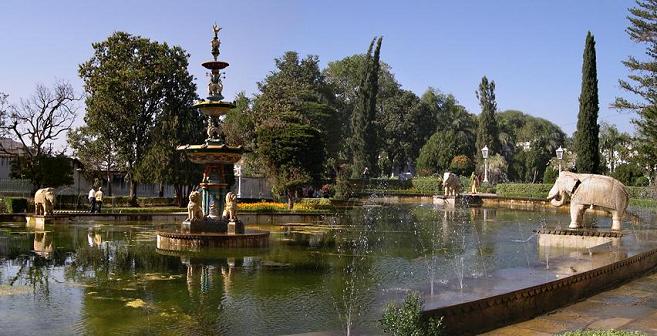 Saheliyon-ki-Bari is a major garden and a popular tourist space in udaipur in Indian state of Rajasthan. It lies in northern part of the city and has fountains and kiosks, a lotus pool and marble elephants. It was built by Maharana Bhopal Singh. Saheliyon ki Bari means Garden of the Maids. There is also a small museum here.
Sahelion Ki Bari' was laid for a group of forty-eight young women attendants who accompanied a princess to udaipur as part of her dowry. The gardens set below the embankment of the Fateh Sagar Lake have beautiful lotus pools, marble pavilions and elephant- shaped fountains. These fountains are fed by the water of the lake gushing through ducts made for the purpose. Each water channel has its distinct sound and the mingling of these sounds complement the ambience of the place.
Saheliyon-ki-Bari is a major garden and a popular tourist space in udaipur in Indian state of Rajasthan. It lies in northern part of the city and has fountains and kiosks, a lotus pool and marble elephants. It was built by Maharana Bhopal Singh. Saheliyon ki Bari means Garden of the Maids. There is also a small museum here.
Sahelion Ki Bari' was laid for a group of forty-eight young women attendants who accompanied a princess to udaipur as part of her dowry. The gardens set below the embankment of the Fateh Sagar Lake have beautiful lotus pools, marble pavilions and elephant- shaped fountains. These fountains are fed by the water of the lake gushing through ducts made for the purpose. Each water channel has its distinct sound and the mingling of these sounds complement the ambience of the place.Garden The flower garden in the palace complex is set up in the large Garden Courtyard. It has yew bushes, jasmine, frangipani trees, bougainvillea, palm trees, nasturtiums, verbena and moss rose. The courtyard itself is covered with black and white tiles. Fountains and water pools, crisscrossed by walkways with low marble handrails, bedeck the garden surroundings. The present Maharana hosts lavish parties here and also rents the place for private parties Jag Mandir at Night 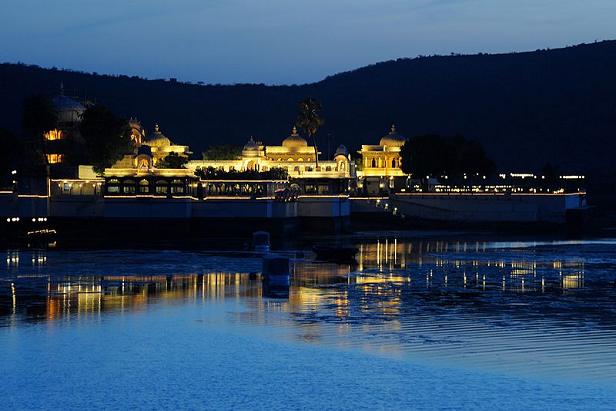 Jag Mandir is the main palace which incorporates the Gul Mahal. The towers of the palace at the corners are octagonal in shape and are topped with cupolas. A labyrinth of reception halls, residential suites and internal courts were built inside the palace, all in Rajput and Mughal architectural styles. The Zenana (residence of royal ladies chambers) adjoins the palace. The Kunwar Pada ka Mahal (the Palace of the Crown Prince) is located at the western end.
Jag Mandir is the main palace which incorporates the Gul Mahal. The towers of the palace at the corners are octagonal in shape and are topped with cupolas. A labyrinth of reception halls, residential suites and internal courts were built inside the palace, all in Rajput and Mughal architectural styles. The Zenana (residence of royal ladies chambers) adjoins the palace. The Kunwar Pada ka Mahal (the Palace of the Crown Prince) is located at the western end.The Suraj Gokhada The balcony of the sun, is where the Suryavanshi Maharanas of Mewar presented themselves to the people in time of trouble to restore their confidence. The 'Mor Chowk' known for its exquisite peacock mosaics in glass and the 'Chini Chitrashala' noted for its blue and white ceramics are other attractions in the Palace. Entry pavilion The pavilion at the entry to the palace is an impressive white colonnade of cusped arches. The landing jetty is also located for docking of boats arriving from the jetty of Bansi Ghat on the main land near City Palace in udaipur. The cruise is through the Pichola Lake. The pavilion is decorated with large elephants carved in stone, four on each side of the entry steps. They face the Lake Palace. The trunks of these elephants were damaged and replaced with polystyrene. The pavilion marks the perimeter of the island in the scenic backdrop of the Aravalli hills. Bagore-ki-Haveli 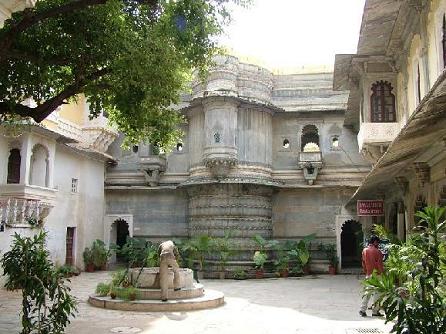 This is an old building built right on the water front of Lake Pichola at Gangori Ghat. Amir Chand Badwa, the Prime Minister of Mewar, built it in the eighteenth century. The palace has over a hundred rooms, with displays of costumes and modern art. The glass and mirror in the interiors are Haveli work. It also preserves an example of Mewar painting on the walls of the Queen's Chamber. The two peacocks made from small pieces of colored glasses are examples of glasswork. After the death of Badwa the building became the property of Mewar State. It came to be occupied by Maharana Shakti Singh of Bagore, who built the palace of the three arches in 1878, and it acquired its name of Bagore-ki-haveli, the house of Bagore. After independence the structure lay in neglect until 1986, when it housed the West Zone Cultural Centre. The haveli now stages Rajasthani traditional dance and music.
This is an old building built right on the water front of Lake Pichola at Gangori Ghat. Amir Chand Badwa, the Prime Minister of Mewar, built it in the eighteenth century. The palace has over a hundred rooms, with displays of costumes and modern art. The glass and mirror in the interiors are Haveli work. It also preserves an example of Mewar painting on the walls of the Queen's Chamber. The two peacocks made from small pieces of colored glasses are examples of glasswork. After the death of Badwa the building became the property of Mewar State. It came to be occupied by Maharana Shakti Singh of Bagore, who built the palace of the three arches in 1878, and it acquired its name of Bagore-ki-haveli, the house of Bagore. After independence the structure lay in neglect until 1986, when it housed the West Zone Cultural Centre. The haveli now stages Rajasthani traditional dance and music. Darikhana Darikhana is on the northern side of the palace, which is an open sided terrace built with marble columns. This place is now run as a restaurant by the present Maharana. Bara Patharon ka Mahal Bara Patharon ka Mahal is located at the eastern wing of the main palace. Mahal is so named because twelve solid marble slabs have been used in its construction. Hence, it is also known as the "Palace of the Twelve Stones. Ahar Museum 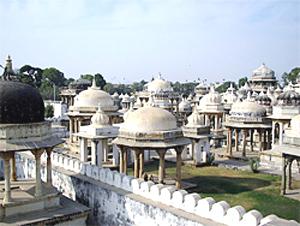 Ahar Museum located about 2 km east of udaipur is a cluster of cenotaphs of the Maharanas of Mewar. There are about nineteen cenotaphs of Maharanas cremated there. One cenotaph is that Maharana Amar Singh, who reigned from 1597 to 1620. Nearby is also Ahar Museum, where on display is limited but very rare earthen pottery, as well as some sculptures and other archaeological finds. Some pieces date back to 1700 BC, and a tenth-century metal figure of Buddha is a special attraction.
Ahar Museum located about 2 km east of udaipur is a cluster of cenotaphs of the Maharanas of Mewar. There are about nineteen cenotaphs of Maharanas cremated there. One cenotaph is that Maharana Amar Singh, who reigned from 1597 to 1620. Nearby is also Ahar Museum, where on display is limited but very rare earthen pottery, as well as some sculptures and other archaeological finds. Some pieces date back to 1700 BC, and a tenth-century metal figure of Buddha is a special attraction.Bharatiya Lok Kala Mandal A museum of folk arts. Also hosts puppet shows in its auditorium. Shilpgram Literally meaning "Craftsmen's Village" is a living ethnographic museum depicting the enormous diversities in craft, art and culture between various Indian states. Shiplgram comprises 26 huts set in 70 acres of natural surroundings at the foot of the Aravali Mountains. Maharana Pratap Memorial or Moti Magri Atop the Moti Magri or Pearl Hill, overlooking the Fateh Sagar Lake is the memorial of the Rajput hero Maharana Pratap with a bronze statue of the Maharana astride his favourite horse "Chetak" . Other Attractions in udaipur Sajjangarh Wildlife Sanctuary 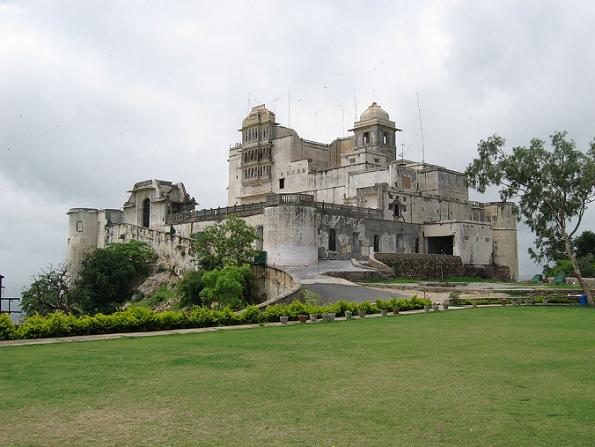 Sajjangarh Wildlife Sanctuary which encircles the palace, was established in 1987. It covers an area of 5.19 square kilometres (2.00 sq mi). It is a well protected sanctuary now with concrete wall of Kishan Pol surrounding it. The hillside is thickly wooded and the former rulers maintained this area as a royal shooting preserve. When udaipur was attacked by the Scindias in 1764, the hill was used as an ordnance dump some cannons still remain
The palace overlooks the sanctuary, which is a reserve for reptiles, tigers, nilgai, sambhar, wild boars, hyenas, panthers, and jackals. It is also popular for bird watching. The reserve can also be approached by a trek (as an adventure) starting from the Gorilla Point to the Jiyan Sagar or the Bari Lake to enjoy the scenic beauty of the Aravalli hills and the wildlife of the reserve forest.
Sajjangarh Wildlife Sanctuary which encircles the palace, was established in 1987. It covers an area of 5.19 square kilometres (2.00 sq mi). It is a well protected sanctuary now with concrete wall of Kishan Pol surrounding it. The hillside is thickly wooded and the former rulers maintained this area as a royal shooting preserve. When udaipur was attacked by the Scindias in 1764, the hill was used as an ordnance dump some cannons still remain
The palace overlooks the sanctuary, which is a reserve for reptiles, tigers, nilgai, sambhar, wild boars, hyenas, panthers, and jackals. It is also popular for bird watching. The reserve can also be approached by a trek (as an adventure) starting from the Gorilla Point to the Jiyan Sagar or the Bari Lake to enjoy the scenic beauty of the Aravalli hills and the wildlife of the reserve forest.udaipur Solar Observatory Asia's only solar observatory, the udaipur Solar Observatory, is situated on an island in the middle of the Lake Fatehsagar, and the main office building is located at its NW shore near the Bari Road - Rani Road Junction. The site is run under the PRL (Physical Research Lab) in Ahemdabad. The sky conditions at udaipur are quite favourable for solar observations.[citation needed] The large body of water surrounding the telescopes decreases the amount of heating of the surface layers, which decreases the turbulence in the air mass and thereby improves the image quality and seeing. Sukhadia Circle 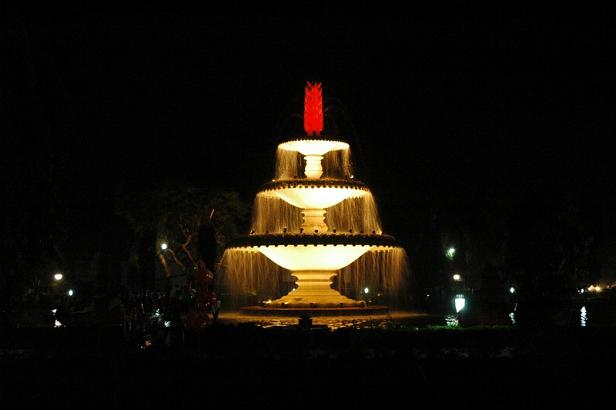 Sukhadia Circle udaipur a large round about in the city's northern suburb of Panchwati, on the road to Ranakpur and Mt. Abu. The centrepiece of the Circle is a large, three-tiered fountain just over 21 m. high, with scalloped dishes surmounted by a wheat-ear motif, representing prosperity. Illuminated at night, it is now a well-known landmark. Its foundation was laid in 1968 and was opened in 1970. The Circle is a popular recreational centre and meeting place. A circular pond surrounds the fountain nearby are pleasant gardens. Families and friends come together, especially at night, when music plays, and dozens of food, cold drinks and tea stalls do a flourishing trade. Children particularly enjoy the experience they float toy boats in the central pond, where odd duck-shaped pedallos (paddle boats) vie for space there is even a mini train nearby. Sukhadia Circle commemorates the memory of udaipur's Mohan Lal Sukhadia, one-time Chief Minister of Rajasthan and a native of udaipur.
Sukhadia Circle udaipur a large round about in the city's northern suburb of Panchwati, on the road to Ranakpur and Mt. Abu. The centrepiece of the Circle is a large, three-tiered fountain just over 21 m. high, with scalloped dishes surmounted by a wheat-ear motif, representing prosperity. Illuminated at night, it is now a well-known landmark. Its foundation was laid in 1968 and was opened in 1970. The Circle is a popular recreational centre and meeting place. A circular pond surrounds the fountain nearby are pleasant gardens. Families and friends come together, especially at night, when music plays, and dozens of food, cold drinks and tea stalls do a flourishing trade. Children particularly enjoy the experience they float toy boats in the central pond, where odd duck-shaped pedallos (paddle boats) vie for space there is even a mini train nearby. Sukhadia Circle commemorates the memory of udaipur's Mohan Lal Sukhadia, one-time Chief Minister of Rajasthan and a native of udaipur. Gulab Bagh and Zoo Gulab Bagh (Sajjan Niwas Garden) is the largest garden in udaipur, Rajasthan. It is spread over 100 acres of land. The garden has innumerable varieties of roses. Gulab Bagh gets its name from the abundance of rose flowers it has. Gulab Bagh was built by Maharana Sajjan Singh in the 1850s. Gulab Bagh also encompasses a museum, originally known as Victoria Hall Museum. It is famous for its collection of antiques, curios, royal household items and other interesting relics from the past. A zoo is situated within the garden, at a short walk away through rose plants and open parks. The zoo, as such, is quite small. Animals and birds of many varieties are housed in cages. But there is enough enjoyment for the kids who can be seen craning their necks to get a glimpse of the tiger or the bear. There is also a small train that meanders within the zoo. There is also a library which was constructed by Maharana Fateh Singh. The library is known as Saraswati Bhawan Library. This library houses books related to history, archaeology, Indology and several manuscripts that date back to the early medieval period. Jagdish Temple 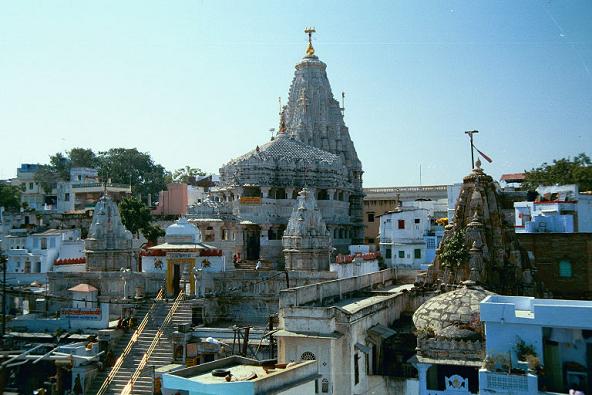 The Jagdish Temple is a large Hindu temple in the middle of udaipur. A big tourist attraction, the temple was originally called the temple of Jagannath Rai, but is now called Jagdish ji. It is a major monument in udaipur. The Jagdish Temple is raised on a tall terrace and was completed in 1651. It attaches a double storeyed Mandapa (hall) to a double - storied, saandhara (that having a covered ambulatory) sanctum. The mandapa has another storey tucked within its pyramidal samavarna (bell - roof) while the hollow clustered spire over the sanctum contains two more, non - functional stories. Lanes taking off from many of the sheharpanah (city wall) converge on the Jagdish Temple. It was built by Maharana Jagat Singh Ist in 1651 A.D. It is an example of Indo - Aryan architecture.
The Jagdish Temple is a large Hindu temple in the middle of udaipur. A big tourist attraction, the temple was originally called the temple of Jagannath Rai, but is now called Jagdish ji. It is a major monument in udaipur. The Jagdish Temple is raised on a tall terrace and was completed in 1651. It attaches a double storeyed Mandapa (hall) to a double - storied, saandhara (that having a covered ambulatory) sanctum. The mandapa has another storey tucked within its pyramidal samavarna (bell - roof) while the hollow clustered spire over the sanctum contains two more, non - functional stories. Lanes taking off from many of the sheharpanah (city wall) converge on the Jagdish Temple. It was built by Maharana Jagat Singh Ist in 1651 A.D. It is an example of Indo - Aryan architecture.Bohara Ganesh JI This temple is situated near old railway station (Thokar) and M L S University. This is old and famous Ganesh Temple with standing statue of Shree Ganesh Ji considered very fruitful (Chamatkarik).Thousands of Bhaktas come here every Wednesday. Lake Pichola 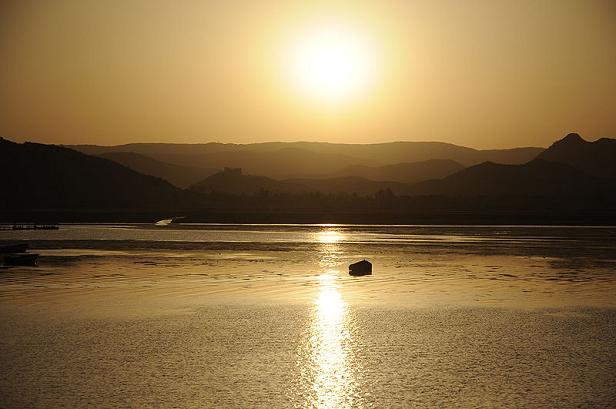 Lake Pichola situated in udaipur city in the Indian state of Rajasthan is an artificial fresh water lake, created in the year 1362 AD, named after the nearby Picholi village
It is one of the several contiguous lakes, and developed over the last few centuries in and around the famous udaipur city. The lakes around udaipur were primarily created by building dams to meet the drinking water and irrigation needs of the city and its neighborhood. Two islands, Jag Niwas and Jag Mandir are located within Pichola Lake, and have been developed with several palaces to provide views of the lake
Three of the numerous lakes found in the vicinity of udaipur which connect with the Pichola lake are the Saroop Sagar Lake connected by an arched bridge built by Maharana Swaroop Singh (1842-1861) which in turn connects to the Fateh Sagar Lake, the crystal watered lake in the midst of tree lined hills and the smaller Arsi vilas.
The Lake Pichola is approachable by road from the udaipur City. Local buses, Tongas, auto-rickshaws and taxis provide the needed transport. udaipur, in turn, is well connected through the Golden Quadrilateral road network, and it lies equidistant, at 650 kilometres, from Delhi and Mumbai on the National Highway (NH) 8. Jaipur, the capital of Rajasthan is 6 hours by road and 3.5 hours drive from Ahmedabad to udaipur. Rajasthan Tourism operates regular bus service from Delhi. It also falls on the East West Corridor which starts from Porbandar and ends at Silchar and intersects the Golden Quadrilateral and a part of this is the stretch from udaipur to Chittor. 25 km from the lake is the Dabok Airport which connects to Delhi and Bombay. udaipur Railway Station and Maharana Pratap Bus Stand are both 3 km away from the Lake.
Pichola Lake was built in 1362 AD by Pichhu Banjara.a gypsy "Banjara" tribesman who transported grain, during the reign of Maharana Lakha. Later, Maharana Udai Singh, impressed by the charm of this lake with the backdrop of green hills, founded the city of udaipur on the banks of the lake and also enlarged the Lake by constructing a stone masonry dam in the Badipol region on the shore of the Lake
The lake's surroundings and the several islands within the lake have been developed over the centuries, with palaces, marble temples, family mansions, bathing ghats or chabutaras (a raised platform, normally within a courtyard) some of the famous ones are the Lake Palace (now converted into a heritage hotel) in the middle of the lake also called the Pichola Palace (pictured) or Jag Nivas located on the Jag Island, the Jag Mandir, the Mohan Mandir (in the northeast corner of the lake built by Jagat Singh between 1628 and 1652), the City Palace of udaipur (Bansi Ghat) from where boats ply to all other parts of the Lake, the Arsi Vilas Island, which is a sanctuary for birds and the Sitamata Game Sanctuary on the western shore of the Lake
At several locations where the lake narrows, ornamental arch bridges have been built to span the waterway between the banks.
Prince Khurram who rebelled against Jahangir, sought refuge of the Mewar King Maharana Karan Singh II in 1623 and was housed in the partially completed Jag Mandir. Price Khurram later usurped the Mughal Empire, took the title of Shah Jahan.
Lake Pichola situated in udaipur city in the Indian state of Rajasthan is an artificial fresh water lake, created in the year 1362 AD, named after the nearby Picholi village
It is one of the several contiguous lakes, and developed over the last few centuries in and around the famous udaipur city. The lakes around udaipur were primarily created by building dams to meet the drinking water and irrigation needs of the city and its neighborhood. Two islands, Jag Niwas and Jag Mandir are located within Pichola Lake, and have been developed with several palaces to provide views of the lake
Three of the numerous lakes found in the vicinity of udaipur which connect with the Pichola lake are the Saroop Sagar Lake connected by an arched bridge built by Maharana Swaroop Singh (1842-1861) which in turn connects to the Fateh Sagar Lake, the crystal watered lake in the midst of tree lined hills and the smaller Arsi vilas.
The Lake Pichola is approachable by road from the udaipur City. Local buses, Tongas, auto-rickshaws and taxis provide the needed transport. udaipur, in turn, is well connected through the Golden Quadrilateral road network, and it lies equidistant, at 650 kilometres, from Delhi and Mumbai on the National Highway (NH) 8. Jaipur, the capital of Rajasthan is 6 hours by road and 3.5 hours drive from Ahmedabad to udaipur. Rajasthan Tourism operates regular bus service from Delhi. It also falls on the East West Corridor which starts from Porbandar and ends at Silchar and intersects the Golden Quadrilateral and a part of this is the stretch from udaipur to Chittor. 25 km from the lake is the Dabok Airport which connects to Delhi and Bombay. udaipur Railway Station and Maharana Pratap Bus Stand are both 3 km away from the Lake.
Pichola Lake was built in 1362 AD by Pichhu Banjara.a gypsy "Banjara" tribesman who transported grain, during the reign of Maharana Lakha. Later, Maharana Udai Singh, impressed by the charm of this lake with the backdrop of green hills, founded the city of udaipur on the banks of the lake and also enlarged the Lake by constructing a stone masonry dam in the Badipol region on the shore of the Lake
The lake's surroundings and the several islands within the lake have been developed over the centuries, with palaces, marble temples, family mansions, bathing ghats or chabutaras (a raised platform, normally within a courtyard) some of the famous ones are the Lake Palace (now converted into a heritage hotel) in the middle of the lake also called the Pichola Palace (pictured) or Jag Nivas located on the Jag Island, the Jag Mandir, the Mohan Mandir (in the northeast corner of the lake built by Jagat Singh between 1628 and 1652), the City Palace of udaipur (Bansi Ghat) from where boats ply to all other parts of the Lake, the Arsi Vilas Island, which is a sanctuary for birds and the Sitamata Game Sanctuary on the western shore of the Lake
At several locations where the lake narrows, ornamental arch bridges have been built to span the waterway between the banks.
Prince Khurram who rebelled against Jahangir, sought refuge of the Mewar King Maharana Karan Singh II in 1623 and was housed in the partially completed Jag Mandir. Price Khurram later usurped the Mughal Empire, took the title of Shah Jahan. Doodh Talai 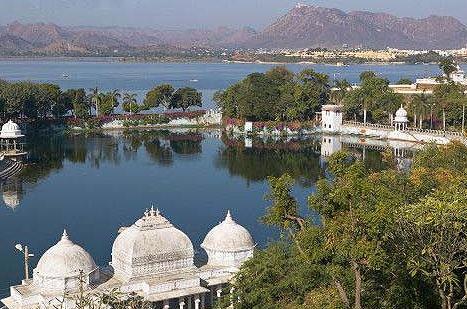 Doodh Talai a rock and fountain garden and the sunset point from which one can enjoy the sunset view in Lake Pichhola and a panoramic view of the old city. Also one can enjoy the Aerial tramway (rope way) which connects one of the dudh talai gardens to Karni Mata temple.
Doodh Talai a rock and fountain garden and the sunset point from which one can enjoy the sunset view in Lake Pichhola and a panoramic view of the old city. Also one can enjoy the Aerial tramway (rope way) which connects one of the dudh talai gardens to Karni Mata temple.Bharatiya Lok Kala Museum The interesting collection exhibited by this Indian folk arts museum includes folk dresses, ornaments, puppets, masks, dolls, folk musical instruments, folk deities and paintings. Shilpgram A crafts village located northwest of udaipur, Shilpgram hosts an annual crafts fair which is one of the biggest in India people from different states in the country have stalls showcasing their art and crafts work. Neemach Mata Temple This temple is located on a green hill in the Dewali area of udaipur. It has both stairs and an uphill slope way to climb, which is around 800 meters. Nehru Garden 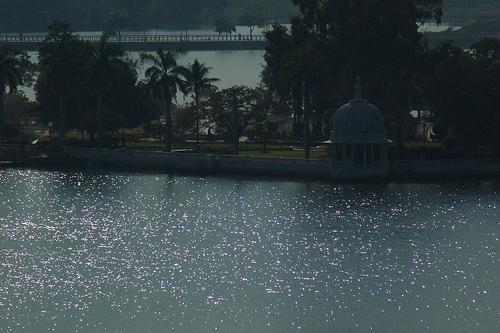 Nehru Garden is situated in the middle of Fateh Sager Lake. This park covers about 170,000 meter square with flower gardens and a lily pond. It was inaugurated on the birth anniversary of the first Prime Minister of India, Jawaharlal Nehru. The garden overlooks the ancient Moti Mahal of Maharana Pratap and gives a view of the Aravalli hills on three sides.
Nehru Garden is situated in the middle of Fateh Sager Lake. This park covers about 170,000 meter square with flower gardens and a lily pond. It was inaugurated on the birth anniversary of the first Prime Minister of India, Jawaharlal Nehru. The garden overlooks the ancient Moti Mahal of Maharana Pratap and gives a view of the Aravalli hills on three sides.
Famous Places Nearby udaipur Nathdwara : Shri Nathdwara (a pathway to Lord Shri Krishna) lies 48 km from udaipur and literally means the gateway to the Lord. Devotees throng the shrine in large numbers during occasions of "Janmashtmi", the day of the Lord's birth, and other festivals like Holi. It is famous for its 'pichwai' paintings, with Shri Krishna in the centre and is recognized for profuse use of gold colour. Ranakpur : A village that is home to one of the most important Jain temples. 1400 plus marble pillars support the temple. Opposite the Jain temple is the much older Sun Temple. Located in Rajsamand District, 110 km north of udaipur. Chittorgarh : About 140 km from udaipur, Chittorgarh was the capital of Mewar from 734 AD to 1559. Chittorgarh Fort is a massive fort situated on a hilltop near Chittorgarh town in Rajasthan state in India. Haldighati : A mountain pass in Rajsamand District that hosted the battle between Rana Pratap Singh of Mewar and the Mughal emperor Akbar. Now a memorial site. Kumbhalgarh : A 15th-century fortress, built by Rana Kumbha of Mewar, with 36 kilometres of walls. Over 360 temples are within the fort. It also has a wildlife sanctuary. Located in Rajsamand District, 64 km from udaipur. The vista from the top of the palace typically extends tens of kilometers into the Aravalli hills. Mount Abu : A popular tourist hill station. Eklingji : Eklingji is a temple complexes situated nearly 22 km in the north of udaipur. It was built in 734 A.D. and consists of 108 temples chiseled out of sandstone and marbles it is devoted to the royal family of Mewar. Kumbhalgarh Wildlife Sanctuary is located in the most rugged of the Aravali in Pali, Rajsamand and udaipur districts of Rajasthan. It takes its name after the historic fort of Kumbhalgarh, which comes into view over the Park. It is 578 km square in area and at an altitude of 500 to 1,300 metres. It is home to a very large variety of wildlife, some of which are highly endangered species. The wildlife includes wolf, leopards, sloth bear, hyena, jackal, jungle cat, smabhar, nilgai, chaisingh (the four horned antelope), chinkara, and here also Kankroli and Rajsamand Lake . Rishabhdeo : Famous Jain pilgrimage center sacred to Jains and local tribals. Chawand : The Third Capital of Mewar and also the place where Great Maharana Pratap spent his last years. Molela : A village near Haldi Ghati famous for its red pottery. |

